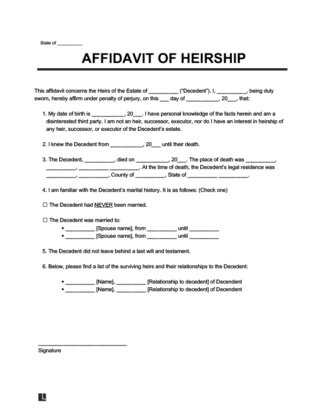
Use our affidavit of heirship form to identify a deceased person’s heirs and speed up the inheritance process.

Updated August 27, 2024
Written by Josh Sainsbury | Reviewed by Susan Chai, Esq.
An affidavit of heirship is a document that identifies the heirs of a person who died without a valid or enforceable will. This form allows a spouse or family member to establish ownership of the deceased’s real property, such as a home or tract of land.
The document presents all known information about the decedent, including all known family relations (spouse, parents, children, siblings, nieces, nephews, etc.) to appropriately distribute the person’s property. The decedent’s heirs must agree on how the property should be distributed.
Without an affidavit of heirship, the surviving spouse or other heirs must use the probate court system to settle an estate. The probate process can be expensive and take months or even years to resolve. While the estate is in probate, the spouse or heir cannot:
Spouses cannot settle outstanding bills or claims against the estate because they cannot access the bank accounts. Therefore, these debts become part of the probate court process.
Each state has statutes regarding the format and required contents of an affidavit of heirship. The most common elements that you must include in the document are:
Here are some common scenarios in which an affidavit of heirship may be used:
When there is no will: An affidavit of heirship is needed when a decedent dies without leaving a valid, enforceable will. Without this document, a decedent risks heirs and loved ones going through a lengthy and expensive probate process to distribute their property.
Informal estate administration: An affidavit of heirship may also be necessary when a decedent’s will expresses their intent to distribute their personal property but fails to state that ownership will transfer to a specified person.
For example, a will might state that the decedent thinks his sister should have his car after he dies because she has to walk to work every day and needs a car. Unfortunately, while the decedent’s intentions are clear, it does not explicitly state that the car title will be transferred to his sister in the event of his death.
Transfer of real estate: If the decedent held real estate, an affidavit of heirship may be necessary to identify the legitimate heirs and make the title transfer process easier. This record assists in proving ownership and can be required for selling, refinancing, or passing the property on to the heirs.
Insurance claims: When submitting a claim for life insurance benefits, the insurance provider could ask for an affidavit of heirship to confirm the payout recipients. This affidavit assists in establishing the connection between the deceased and the potential heirs, ensuring that the insurance payments are distributed fairly.
Banking and financial matters: An affidavit of heirship may be required to prove the heirs’ right to the deceased person’s bank accounts, investments, or other financial assets. This can make managing the decedent’s finances and money transfers easier.
The affiant is the person who is filling out the affidavit. For the case of this document, the affiant has to be a disinterested third party who can testify to the relationship of the surviving spouse(s) and/or heir(s) for the transfer of personal property and/or real property. In this section, make sure to include your:
For the next step, you need to provide information about the person who has died. Include the following:
You should include the marital information of the decedent, providing the following details if possible:
If the decedent had multiple marriages, include this information for all spouses.
Write down any surviving heirs the decedent has and their relationship to them.
This step involves including the governing law of the affidavit and the date of the document. The governing law will determine how the affidavit is interpreted during a dispute.
You must sign the document in the presence of a notary public. Getting the affidavit notarized will help confirm the document’s authenticity in case of any disagreement. Additionally, a witness is also required, whether it’s one or two depends on the governing state.
You can download our free affidavit of heirship template in PDF or Word below to get started or create a custom affidavit using our document builder.